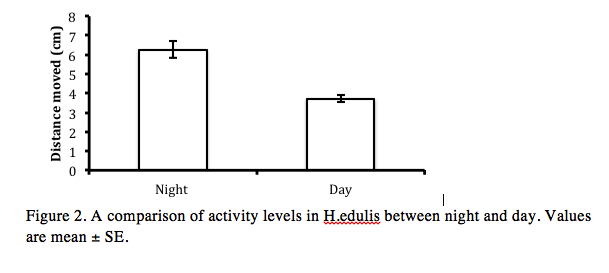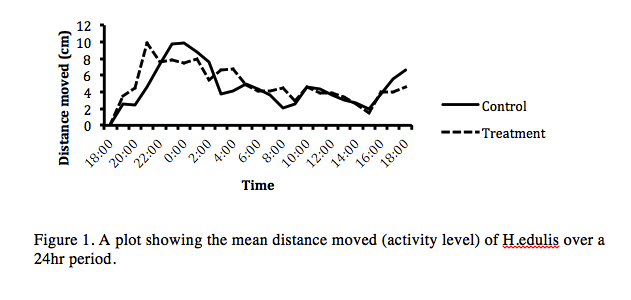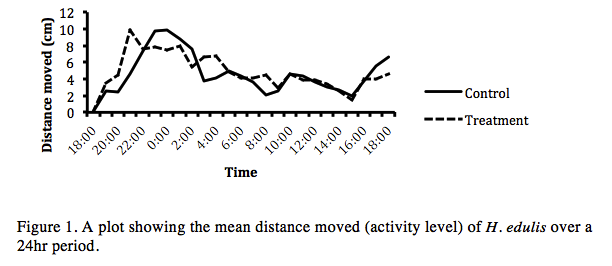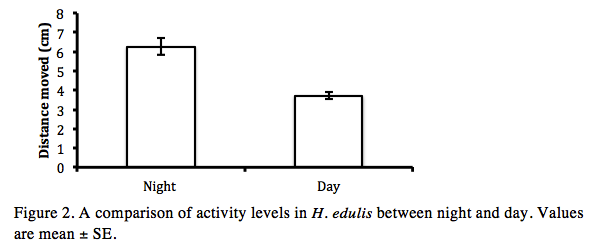CYCLICITY
Holothuria edulis’ activity patterns are explained by an endogenously controlled circadian rhythm.
Holothurians fill a vital ecological niche in coral reef ecosystems in the form of bioturbation. Bioturbation is found to enhance aeration of the sediment, and can reduce both the bacterial and microalgal loads of a coral reef [7]. Although Wheeling et al. (2007) [10] has suggested that H. edulis is nocturnal, this study aimed to provide empirical data to confirm this, as well as determining when H. edulis was most actively bioturbating. In addition I hoped to determine whether this activity is controlled by an inbuilt body clock (circadian rhythm) or whether activity levels may vary with other factors such as day length. If day length were to be the controlling factor, we may see differences in bioturbation between summer and winter months. As it has been suggested [7] holothurians reduce algal and bacterial loads on coral reefs, variation in bioturbation activity may lead to increases in algal and bacterial loads over the summer months with increased day length. I hypothesise that H. edulis will be more active during the night and that activity levels are in fact controlled by an endogenous circadian rhythm, rather than via external environmental factors.
Four individual sea cucumbers were independently maintained in controlled, flow through tanks over a 48hr period in an attempt to determine whether activity levels in H.edulis are controlled via a circadian rhythm. Two individual controls were kept on a 12-12 d/n cycle while the two treatments had a reversed 12-12 d/n cycle. All specimens were acclimated to their light-dark patterns for 24hrs before data was collected. Specimens were kept in 35 x 28cm plastic tanks with an equal covering of sand and continually pumped seawater. The light in the room was kept on permanently and covering the tanks with black PVC bins regulated night cycles. This only allowed a small amount of light it, similar to natural star and moonlight.
Activity was measured and recorded hourly as the distance moved from the anterior end over a 24hr period. Results were analysed using student’s t-tests to determine whether there was a difference in activity between day and night, and also to determine if activity patterns significantly differed between controls and treatments.
Results show that there was no significant difference in activity levels between controls and treatments (p=0.58) over the 24hr-monitoring period. This was also found to be the case when comparing activity during the day and night periods independently (p=0.83 and p=0.42 respectively). Figure 1 clearly indicates peak activity occurred between 1800 and 0600hrs, while throughout the day, activity levels were reduced in both control and treatments. There was a significant difference in activity levels between day and night (p=<0.001), with both control and treatments shown to be more active throughout the night.
  


Results from this study suggest that activity in H. edulis is controlled by a circadian rhythm, as there was no significant difference in activity levels between treatment and controls, confirming my hypothesis. Other cyclic factors such as tidal rhythms and day light levels can be ruled out as potential confounding factors as these were controlled for in the experimental design. I also found that H. edulis was in fact significantly more active throughout the night compared to the day, providing support for suggestions made by Wheeling et al. (2007) [10]. Results from this study imply that even when daylight hours are increased, for example during summer months, the bioturbation patterns of H. edulis will not differ, and nutrient cycling on coral reefs will not be affected. |